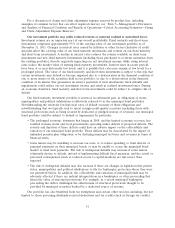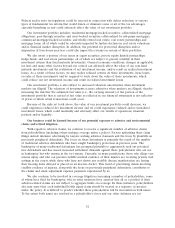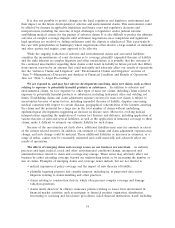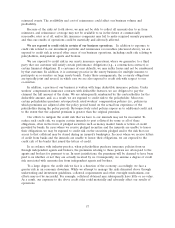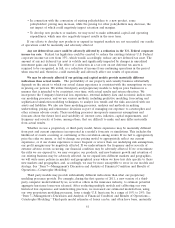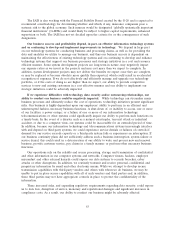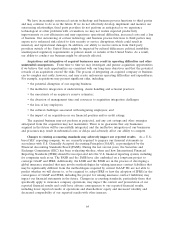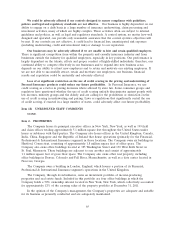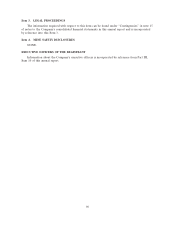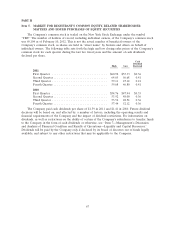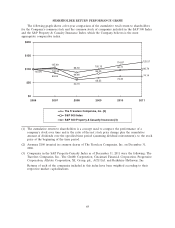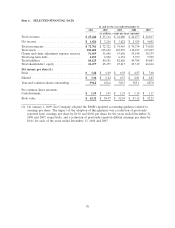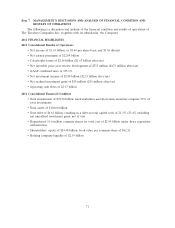Travelers 2011 Annual Report Download - page 73
Download and view the complete annual report
Please find page 73 of the 2011 Travelers annual report below. You can navigate through the pages in the report by either clicking on the pages listed below, or by using the keyword search tool below to find specific information within the annual report.• In connection with the conversion of existing policyholders to a new product, some
policyholders’ pricing may increase, while the pricing for other policyholders may decrease, the
net impact of which could negatively impact retention and margins.
• To develop new products or markets, we may need to make substantial capital and operating
expenditures, which may also negatively impact results in the near term.
If our efforts to develop new products or expand in targeted markets are not successful, our results
of operations could be materially and adversely affected.
Any net deferred tax asset could be adversely affected by a reduction in the U.S. Federal corporate
income tax rate. Federal tax legislation could be enacted to reduce the existing statutory U.S. Federal
corporate income tax rate from 35%, which would, accordingly, reduce any net deferred tax asset. The
amount of any net deferred tax asset is volatile and significantly impacted by changes in unrealized
investment gains and losses. The effect of a reduction in a tax rate on net deferred tax assets is
required to be recognized, in full, as a reduction of income from continuing operations in the period
when enacted and, therefore, could materially and adversely affect our results of operations.
We may be adversely affected if our pricing and capital models provide materially different
indications than actual results. The profitability of our property and casualty business substantially
depends on the extent to which our actual claims experience is consistent with the assumptions we use
in pricing our policies. We utilize third-party and proprietary models to help us price business in a
manner that is intended to be consistent, over time, with actual results and return objectives. We
incorporate the Company’s historical loss experience, external industry data and economic indices into
our modeling processes, and we use various methods, including predictive modeling, forecasting and
sophisticated simulation modeling techniques, to analyze loss trends and the risks associated with our
assets and liabilities. We also use these modeling processes, analyses and methods in making
underwriting, pricing and reinsurance decisions as part of managing our exposure to catastrophes and
other extreme adverse events. These modeling processes incorporate numerous assumptions and
forecasts about the future level and variability of: interest rates, inflation, capital requirements, and
frequency and severity of losses, among others, that are difficult to make and may differ materially
from actual results.
Whether we use a proprietary or third-party model, future experience may be materially different
from past and current experience incorporated in a model’s forecasts or simulations. This includes the
likelihood of events occurring or continuing or the correlation among events. If we fail to appropriately
price the risks we insure, or fail to change our pricing model to appropriately reflect our current
experience, or if our claims experience is more frequent or severe than our underlying risk assumptions,
our profit margins may be negatively affected. If we underestimate the frequency and/or severity of
extreme adverse events occurring, our financial condition may be adversely affected. If we overestimate
the risks we are exposed to, we may overprice our products, and new business growth and retention of
our existing business may be adversely affected. As we expand into different markets and geographies,
we will write more policies in markets and geographical areas where we have less data specific to these
new markets and geographies, and, accordingly, we may be more susceptible to error in our models and
strategy. See ‘‘Item 7—Management’s Discussion and Analysis of Financial Condition and Results of
Operations—Catastrophe Modeling.’’
Third party models may provide substantially different indications than what our proprietary
modeling processes provide. For example, during the first quarter of 2011, a new version of a third-
party computer model utilized by us, as well as others in the insurance industry, to estimate potential
aggregate hurricane losses was released. After evaluating multiple models and calibrating our own
historical loss experience and underwriting practices, we increased our estimated modeled loss, using
our own proprietary modeling processes, from a single U.S. hurricane by a range of 10% to 24%. See
‘‘Item 7—Management’s Discussion and Analysis of Financial Condition and Results of Operations—
Catastrophe Modeling.’’ Third-party model estimates of losses can be, and often have been, materially
61


